

Pio Fedi (31 May 1816, Viterbo - 1 June 1892, Florence) was an Italian sculptor who worked chiefly in the Romantic style. [1]


Pio Fedi (31 May 1816, Viterbo - 1 June 1892, Florence) was an Italian sculptor who worked chiefly in the Romantic style. [1]
He was born to Leopoldo Fedi, a small landowner, and his wife, Camilla née Franchini. Due to economic difficulties, they left Viterbo when he still quite young; living in Arezzo and Florence. There, he worked for a goldsmith. This led to lessons in engraving from Raffaello Sanzio Morghen and Giovita Garavaglia. From 1838 to 1840, he lived in Vienna with his father and continued his studies at the Academy of Fine Arts, but he was forced to abandon that potential career due to eye problems caused by the acid fumes. [2]
After returning to Florence, from 1842 to 1846 he studied sculpture with Lorenzo Bartolini at the Academy of Fine Arts. There, he obtained a scholarship that enabled him to study in Rome at the Accademia di San Luca. His primary instructor there was Pietro Tenerani. One his first independent works, a plaster relief of "Christ the Healer", is preserved at San Luca. In 1873, the Accademia named him an "Academician of Merit". [2]
His most familiar sculpture is the Rape of Polyxena (1866), in the Loggia dei Lanzi. He is also known for two sculptures in the Loggiato degli Uffizi depicting the illustrious Tuscans, Nicola Pisano and Andrea Cesalpino. His other works include The Fury of Atamante, King of Thebes, The Genius of Fishing, Hope Nourishing Love, Hyppolite and Dianora del Bardi, and Castalla persecuted by Apollon. [3]
In addition, he designed the Monument to General Manfredo Fanti, molded in bronze by Clemente Papi , which stands in the Piazza San Marco. [3] His memorial to the poet Giovanni Battista Niccolini is in the church of Santa Croce. The statue, an allegory of the Freedom of Poetry, may have inspired Bartholdi's depiction of the Statue of Liberty. [4] He also created a statue of Pietro Torrigiani, the Mayor of Florence.
From 1842, he had a studio at 99 Via dei Serragli , in an old monastery. Currently an actor's training school, it is still known as the Galleria Pio Fedi . One of his best known students was Giovanni Bastianini.

The Accademia di Belle Arti di Firenze is the oldest public institution of fine arts training in the world. Founded in 1563 by Cosimo I de' Medici under the influence of Giorgio Vasari, it was subsequently reorganized at the initiative of the Grand Duke of Tuscany and separated from the Accademia delle Arti del Disegno in 1784. Michelangelo, Benvenuto Cellini and other significant artists have been associated with it. Like other state art academies in Italy, it became an autonomous degree-awarding institution under law no. 508 dated 21 December 1999, and falls under the administration of the Ministero dell'Istruzione, dell'Università e della Ricerca, the Italian ministry of education and research. The adjacent Galleria dell'Accademia houses the original David by Michelangelo.

The Loggia dei Lanzi, also called the Loggia della Signoria, is a building on a corner of the Piazza della Signoria in Florence, Italy, adjoining the Uffizi Gallery. It consists of wide arches open to the street. The arches rest on clustered pilasters with Corinthian capitals. The wide arches appealed so much to the Florentines that Michelangelo proposed that they should be continued all around the Piazza della Signoria.
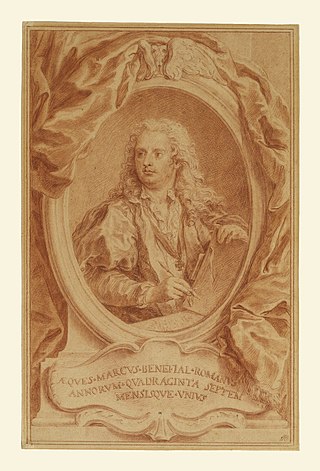
Marco Benefial was an Italian, proto-Neoclassical painter, mainly active in Rome. Benefial is best known for his repudiation of 18th century decorative Rococo styles pre-eminent in the Rome dominated by Carlo Maratta pupils. His paintings portrayed tangible human figures, with complex treatment of space, and luminous, warm colors. Along with the altarpieces and frescoes, he also painted many portraits. Because he partnered with some inferior artists who subsequently received credit, some of his paintings have been frequently misidentified.

Gaetano Trentanove was an Italian and American sculptor.
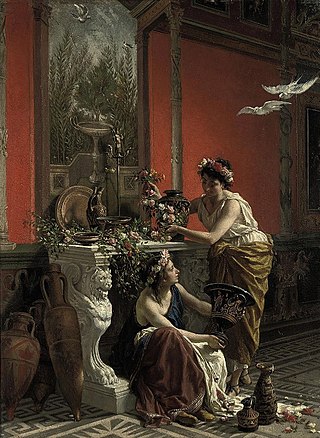
Cesare Mariani was an Italian painter and architect of the late-19th century, active in Rome and Ascoli Piceno.

Giovanni Maria Morandi was an Italian Baroque painter, known for altarpieces and portraits.
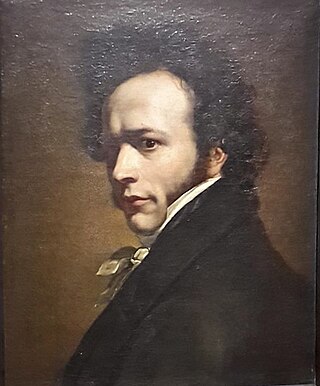
Giovanni Battista Biscarra or Jean-Baptiste Biscarra was an Italian painter, sculptor and lithographer. He principally painted historical and religious subjects and royal portraits.

Francesco Mancini was an Italian painter whose works are known between 1719 and 1756. He was the pupil of Carlo Cignani.

Tito Sarrocchi was an Italian sculptor.
Ignazio Jacometti was an Italian sculptor. He was a professor of sculpture at the Accademia di San Luca.
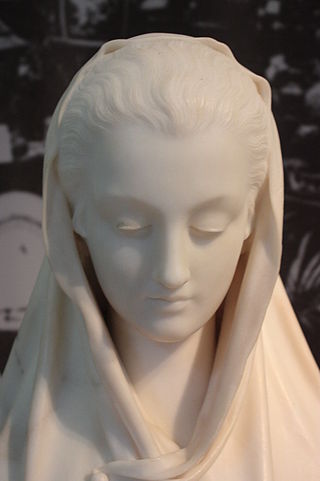
Giosuè Argenti was an Italian sculptor.
Giovanni Battista Tassara was an Italian sculptor.
Pio Siotto was an Italian artist active as a cameo engraver.
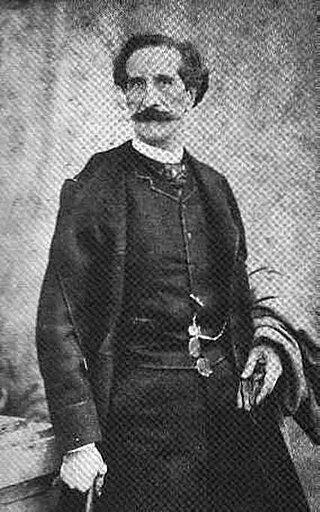
Cesare Sighinolfi was an Italian sculptor.

Napoleone Verga was an Italian painter, mainly of illuminated manuscripts, but also of paintings.
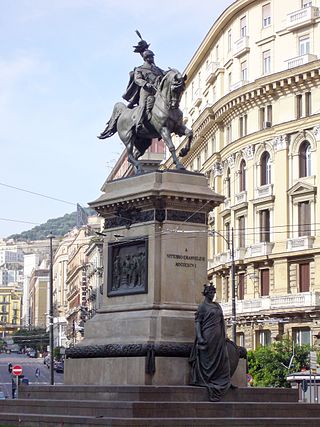
Tommaso Solari was an Italian sculptor active in a Romantic-style.
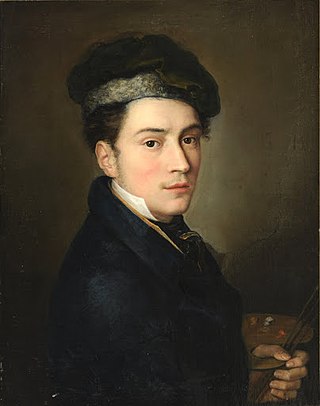
Pietro Gagliardi was an Italian painter and architect, who decorated many churches and palaces in Rome and throughout Italy.

The Cappella di San Luca, also called dei Pittori is a chapel found in the cloisters of the convent of Santissima Annunziata in Florence, Italy. It was built to serve as the burial chapel for members of the Accademia delle Arti del Disegno, and was donated by the Servites to the Academy in a document from 1565. It contains a collection of terracota statues from a number of prominent Florentine Mannerist sculptors.

Antonio Cipolla was an Italian architect, active in an academic neo-Renaissance style.
![]() Media related to Pio Fedi at Wikimedia Commons
Media related to Pio Fedi at Wikimedia Commons